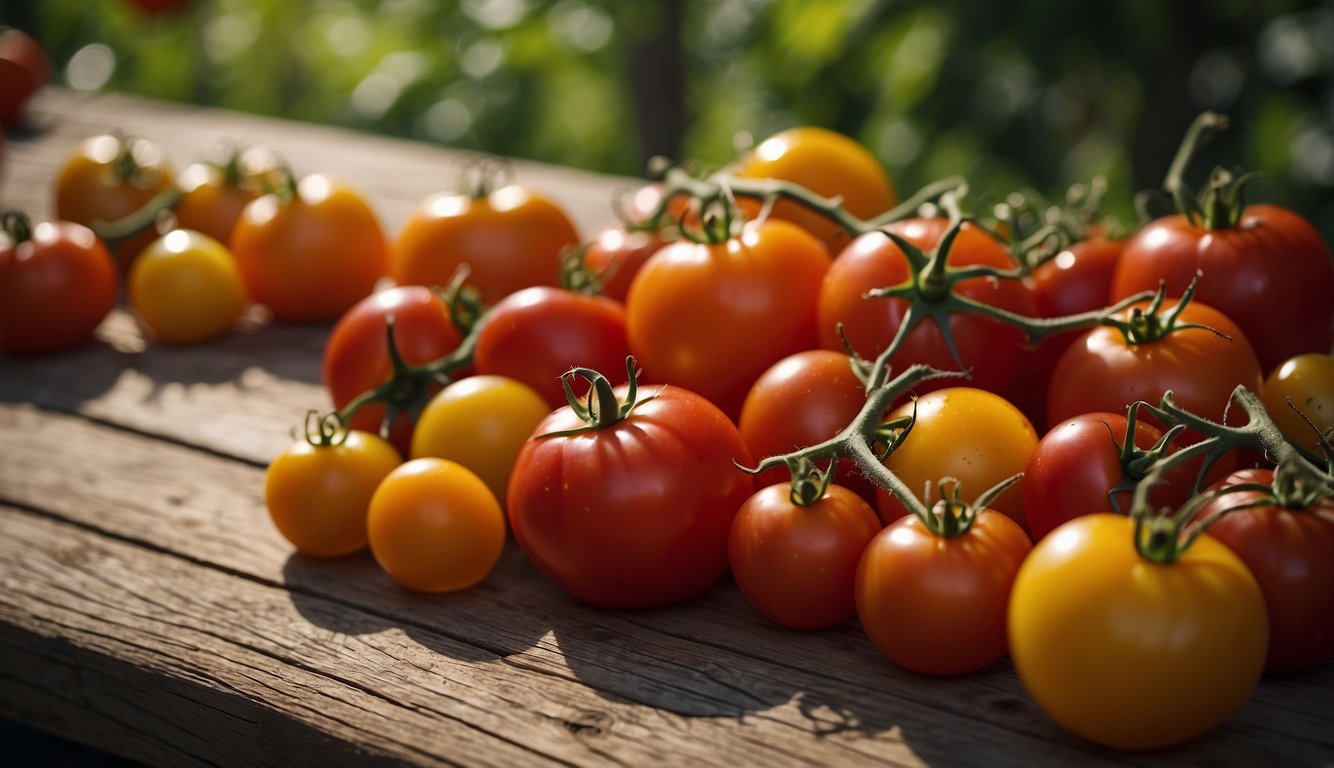TheHerbProf.com is a treasure trove of knowledge for those interested in natural healing and herbal remedies. The website is run by Paul Johnston MD. A naturopathic who has not only received extensive education in the field but also has personal experience in self-healing.
When it comes to cooking, tomatoes are one of the most versatile ingredients out there. There are dozens of types of tomatoes, each with its own unique flavor, texture, and color.
From the juicy and sweet cherry tomatoes to the meaty and tart San Marzano, there is a tomato for every dish and palate.
Tomatoes are technically a fruit, but they are commonly used as a vegetable in savory dishes.
They are rich in vitamins A and C, as well as potassium and lycopene, a powerful antioxidant.
Tomatoes are also low in calories, making them a healthy addition to any meal.
Whether you’re making a classic tomato sauce, a refreshing gazpacho, or a colorful caprese salad, knowing the different types of tomatoes can help you achieve the perfect flavor and texture.
History and Botany
As a tomato enthusiast, I find the history and botany of this fruit fascinating. In this section, I will share some of the interesting facts and information I have learned about tomatoes.
Origins of Tomatoes
Tomatoes, scientifically known as Solanum lycopersicum, are native to South America.
The earliest evidence of tomato cultivation dates back to the Incas in Peru, where they were grown as early as 700 AD.
The Spanish explorers brought tomatoes back to Europe in the 16th century, where they quickly became popular as a food ingredient.
Tomatoes in the Nightshade Family
Tomatoes belong to the nightshade family, which also includes potatoes, eggplants, and peppers. The scientific name for this family is Solanaceae.
Interestingly, many plants in this family are toxic, but the tomato is safe to eat.
One of the fascinating things about the nightshade family is the diversity of plants within it.
For example, there are thousands of tomato varieties, including heirlooms, which are open-pollinated varieties that have been passed down for generations.
Tomato Varieties
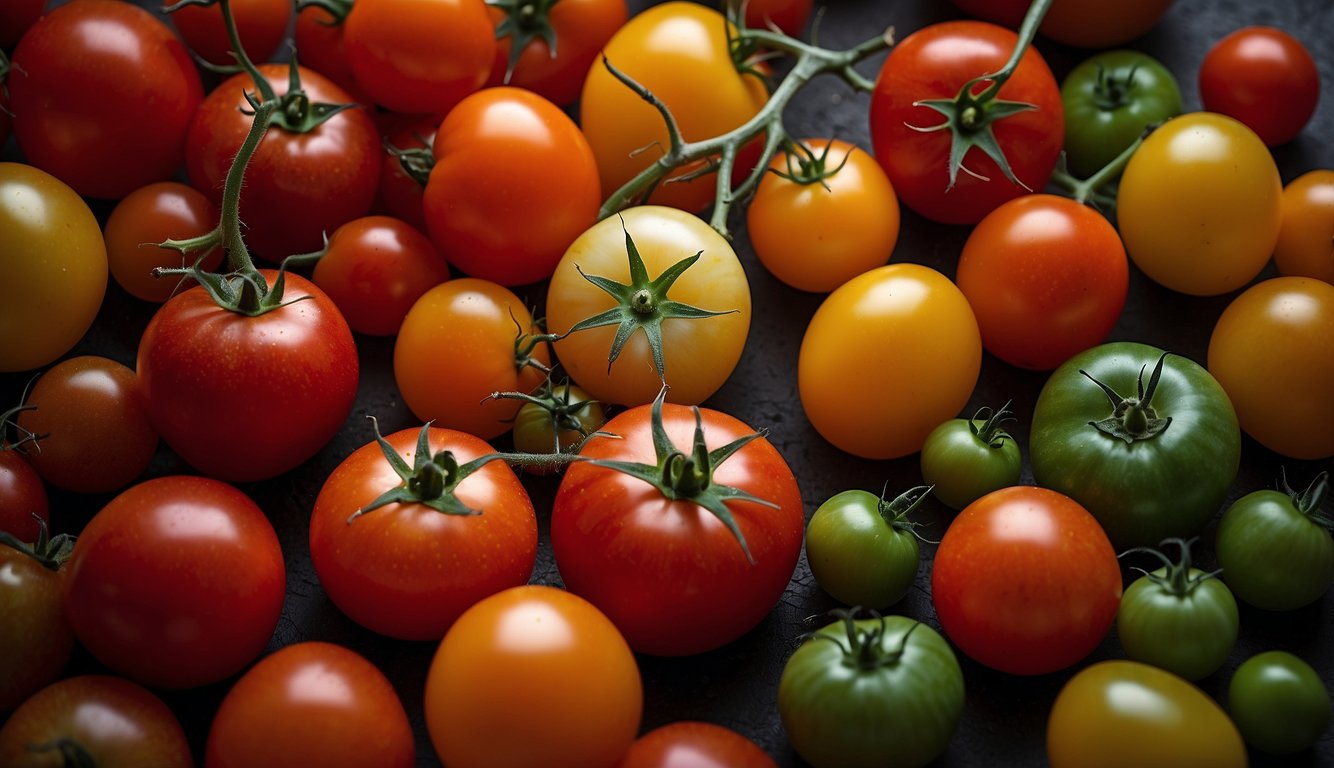
When it comes to tomatoes, there are a variety of options to choose from. In this section, I will discuss some of the most common types of tomatoes, including heirloom and hybrid varieties, as well as determinate and indeterminate types.
Heirloom Tomatoes – Types of Tomatoes
Heirloom tomatoes are known for their unique flavors and colors.
These tomatoes are typically open-pollinated, meaning that they are pollinated naturally by insects, birds, or wind.
They are often grown from seeds that have been passed down from generation to generation, making them a favorite among gardeners.
Some common heirloom tomato varieties include the Brandywine, Cherokee Purple, and Green Zebra.
These tomatoes are often larger than other varieties and can have a range of colors, from deep red to yellow and green.
Hybrid Tomatoes
Hybrid tomatoes are created by crossbreeding two different tomato plants. This is done to create a plant with desirable traits, such as disease resistance or a longer shelf life.
Hybrid tomatoes are often more uniform in size and shape than heirloom varieties.
Some popular hybrid tomato varieties include the Early Girl, Celebrity, and Better Boy.
These tomatoes are often smaller than heirloom varieties and come in a range of colors, from red to yellow and orange.
Determinate and Indeterminate Tomatoes
Tomatoes can also be classified as either determinate or indeterminate.
Determinate tomatoes are often referred to as “bush” tomatoes, as they grow to a certain size and then stop.
These tomatoes are often preferred by gardeners with limited space, as they do not require as much room to grow.
Indeterminate tomatoes, on the other hand, continue to grow and produce fruit throughout the growing season.
These tomatoes are often referred to as “vine” tomatoes, as they require support to keep them from falling over.
Some common varieties of determinate tomatoes include Roma and San Marzano tomatoes, which are often used for making sauces and canning.
Indeterminate varieties include beefsteak, cherry, and grape tomatoes, which are often eaten fresh or used in salads.
Culinary Uses – Types of Tomatoes
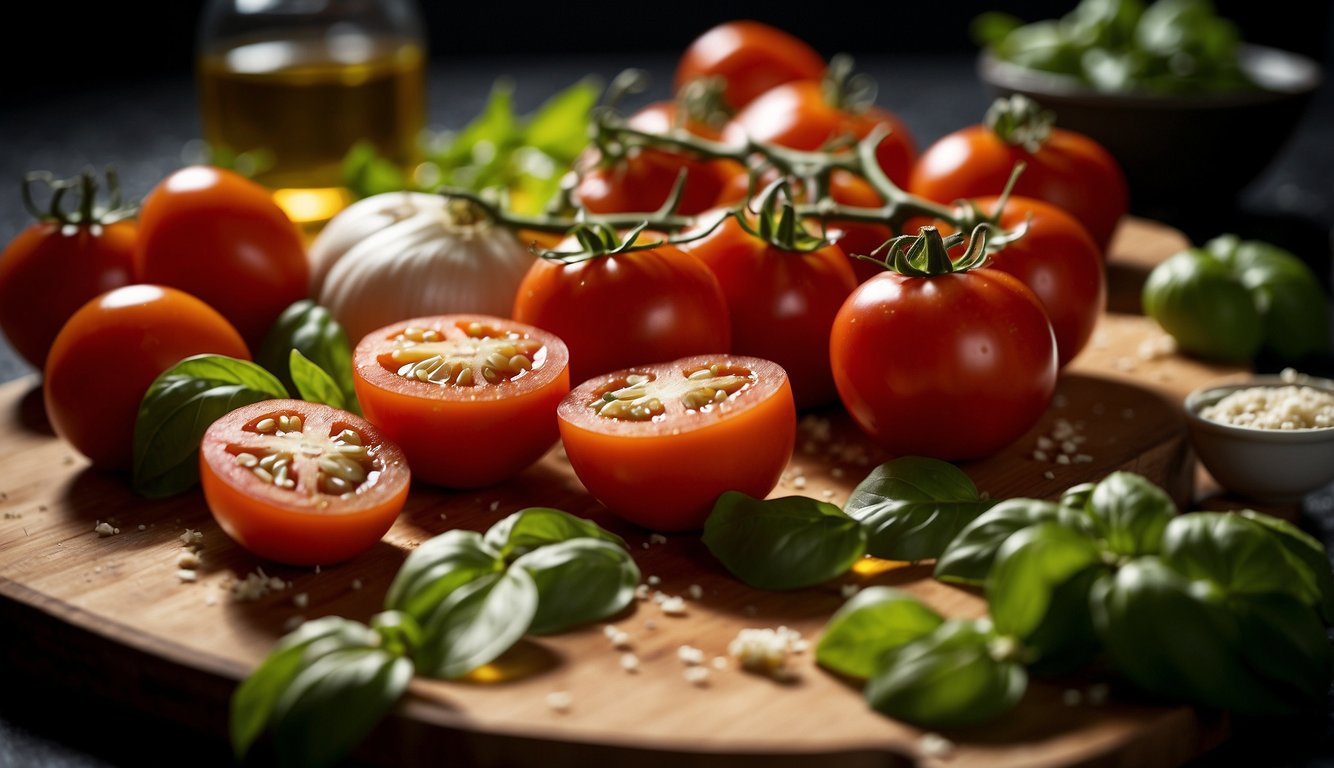
As a versatile ingredient, tomatoes are used in a variety of dishes, from salads to sauces. Here are some of the most common culinary uses of tomatoes:
Tomatoes in Salads – Types of Tomatoes
Tomatoes are a staple ingredient in many salads, adding a burst of flavor and color.
Cherry and grape tomatoes are perfect for salads, as they are small and sweet.
Slicing tomatoes are also a great option, especially in Caprese salads. Simply slice the tomatoes and layer them with fresh mozzarella cheese and basil leaves.
Tomatoes in Sauces
Tomatoes are the base of many sauces, including marinara, pizza sauce, and tomato soup.
Paste tomatoes, such as Roma and San Marzano, are ideal for sauces because they contain less water and more flesh.
Beefsteak tomatoes are also a good option for sauces because they have a meaty texture and rich flavor.
Tomatoes in Sandwiches and Snacks
Tomatoes are a popular addition to sandwiches, adding a juicy and refreshing element.
Slicing tomatoes are great for sandwiches, especially BLTs.
Cherry and grape tomatoes are perfect for snacking, either on their own or in charcuterie boards.
Nutritional Profile – Types of Tomatoes
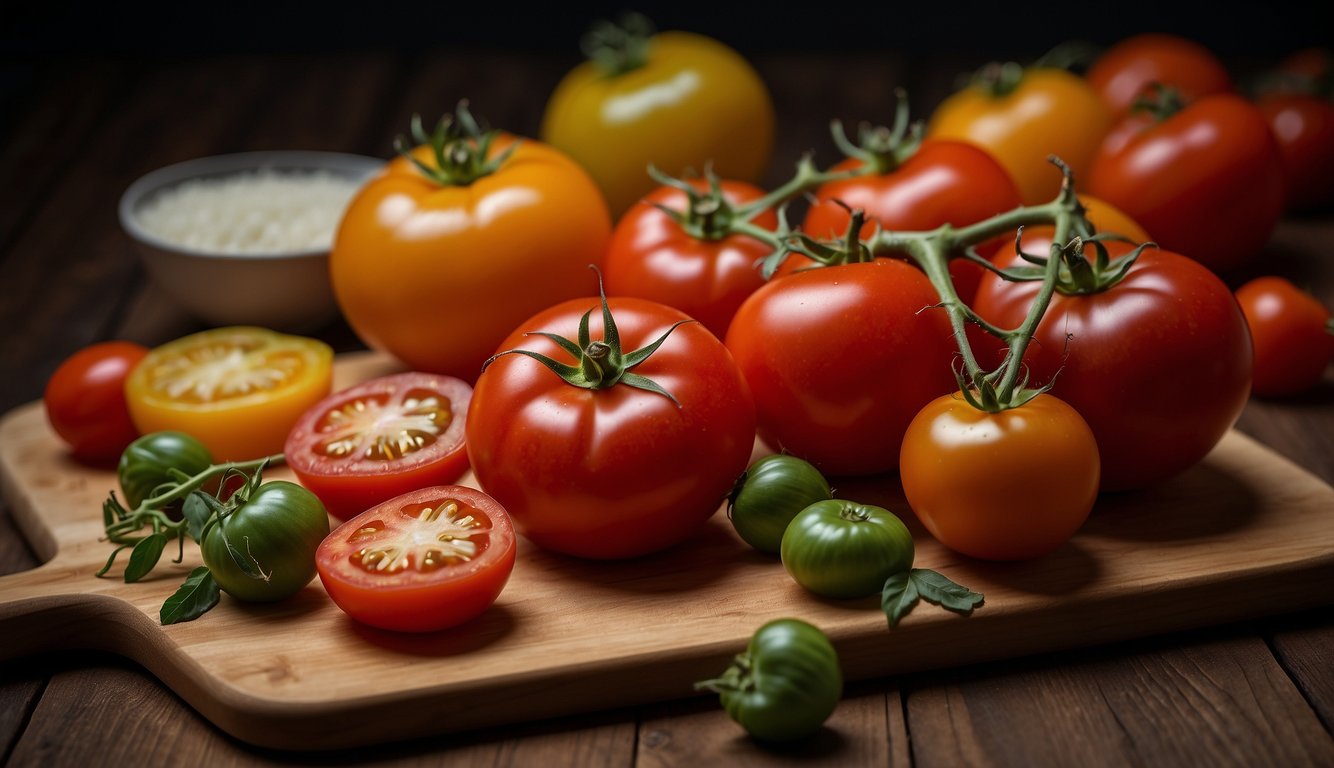
Tomatoes are a nutrient-dense food that contains a variety of essential vitamins and minerals.
They are low in calories and high in water content, making them a great option for those watching their weight.
Vitamins and Antioxidants – Types of Tomatoes
Tomatoes are an excellent source of vitamin C, a powerful antioxidant that helps protect cells from damage caused by free radicals.
One medium-sized tomato contains about 28% of the recommended daily intake of vitamin C.
Another important antioxidant found in tomatoes is lycopene, which has been linked to a reduced risk of heart disease and certain types of cancer.
Lycopene is a carotenoid pigment that gives tomatoes their red color.
Dietary Fiber and Sugar Content
Tomatoes are also a good source of dietary fiber, which helps promote healthy digestion and can lower cholesterol levels. One medium-sized tomato contains about 1.5 grams of fiber.
In terms of sugar content, tomatoes are relatively low compared to other fruits. One medium-sized tomato contains about 3 grams of sugar.
However, it’s important to note that some tomato products (such as ketchup and tomato sauce) can be high in added sugars.
Physical Characteristics – Types of Tomatoes
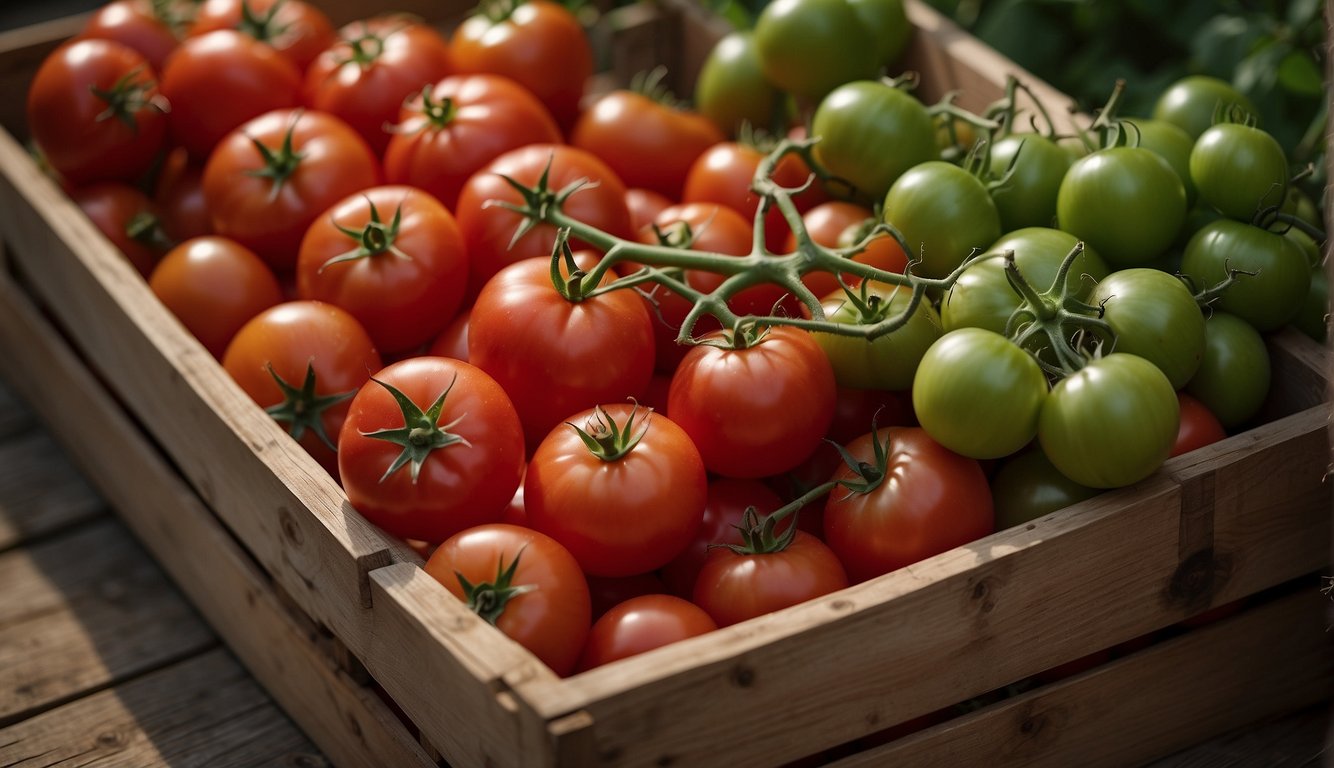
As a tomato enthusiast, I find it fascinating to learn about the different physical characteristics of tomatoes.
Tomatoes come in various colors, shapes, and sizes, making them a versatile fruit that can be used in many different dishes.
Color Variations – Types of Tomatoes
Tomatoes come in a range of colors, from the classic red to yellow, green, orange, and even black.
The most common color of tomatoes is red, which is due to the presence of lycopene, a pigment that gives the fruit its red color.
Yellow and orange tomatoes are also popular and have a sweeter taste than red tomatoes.
Green tomatoes are unripe and have a tart, acidic flavor, while black tomatoes have a rich, smoky flavor.
Fruit Shape and Size
Tomatoes come in various shapes and sizes, with some being round, while others are oblong or pear-shaped.
The most common tomato shape is round, which is what most people think of when they picture a tomato.
However, there are also cherry tomatoes, which are small and round, and plum tomatoes, which are oblong and have a pointed end.
Tomatoes also come in different sizes, ranging from small cherry tomatoes to large beefsteak tomatoes.
The size of the tomato is usually determined by the variety, with some varieties producing larger fruits than others.
Growing Tomatoes – Types of Tomatoes

As an avid tomato grower, I have learned a lot about the different types of tomatoes and their growth habits. In this section, I will share my knowledge on tomato growth habit and cultivation in home gardens.
Tomato Growth Habit – Types of Tomatoes
Tomatoes can have either a determinate or indeterminate growth habit.
Determinate tomatoes are also known as “bush” tomatoes and grow to a predetermined height, typically around 2.5 to 4 feet tall. They produce all their fruit within a relatively short period, making them ideal for making sauces and canning.
On the other hand, indeterminate tomatoes are also known as “vining” tomatoes and keep growing until the first frost. This growth habit allows them to produce fruit continuously throughout the growing season.
Some popular determinate tomato varieties include Green Zebra and Mountain Magic, while popular indeterminate varieties include Better Boy and Sungold.
Cultivation in Home Gardens
Tomatoes are a popular choice for home gardeners, and for good reason. They are relatively easy to grow and produce a bountiful harvest.
When cultivating tomatoes, it is important to choose a sunny location with well-draining soil.
Tomatoes require a lot of water, so be sure to keep the soil consistently moist.
One way to support indeterminate tomatoes is by using a trellis or tomato cage. This will keep the plant upright and prevent the fruit from touching the ground, which can cause rot. For determinate tomatoes, staking may be sufficient.
In addition to watering and support, tomatoes also require regular fertilization.
A balanced fertilizer with equal parts nitrogen, phosphorus, and potassium is ideal.
It is important to follow the manufacturer’s instructions and not over-fertilize, as this can lead to excessive foliage growth and fewer fruits.
Preservation Methods – Types of Tomatoes
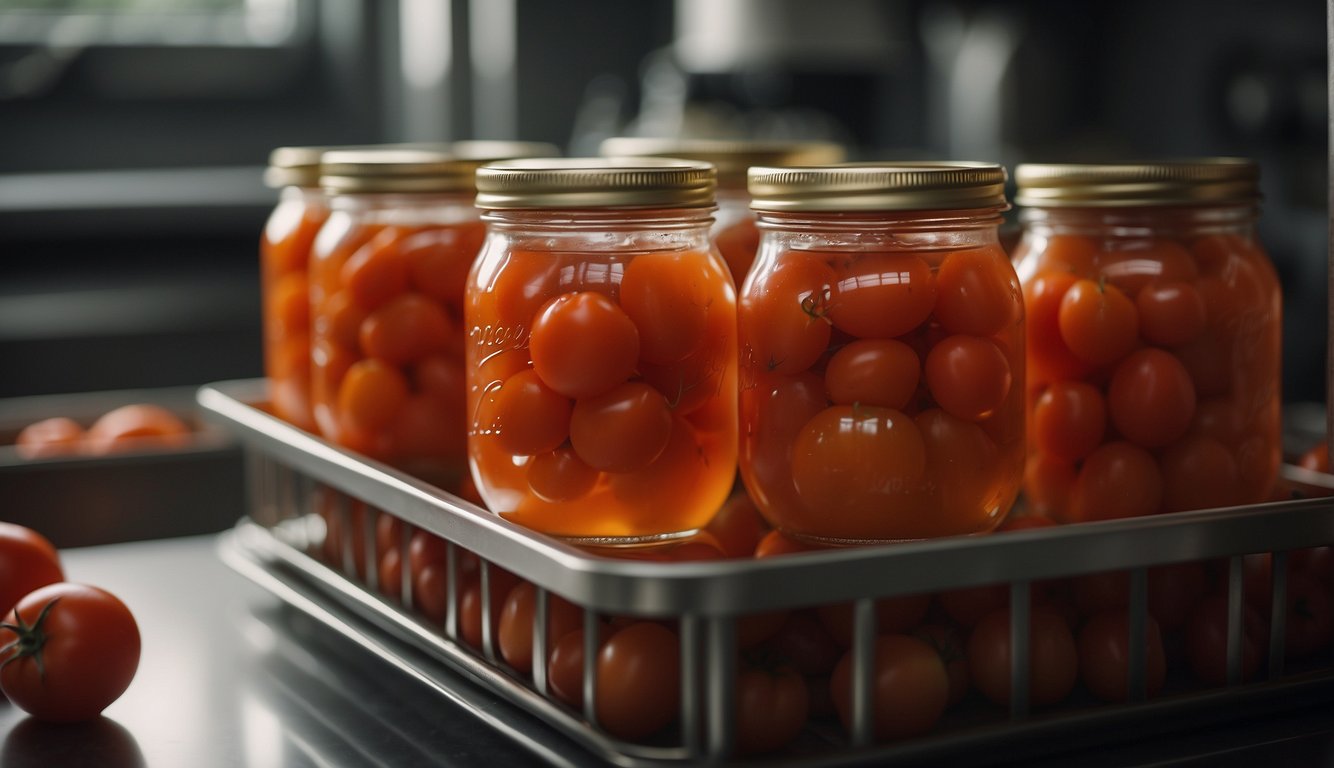
Preserving tomatoes is a great way to enjoy their taste and nutrients all year round.
There are various methods for preserving tomatoes, including canning, pickling, making tomato paste, and sauce.
Types of Tomatoes – Canning and Pickling
Canning and pickling are great ways to preserve tomatoes for later use.
Canning involves processing the tomatoes in a hot water bath or pressure canner to kill bacteria and ensure long-term preservation.
Pickling, on the other hand, involves immersing the tomatoes in vinegar, salt, and spices to create a tangy, flavorful snack.
When canning or pickling tomatoes, it’s important to use fresh, ripe tomatoes. Green tomatoes can also be used for pickling.
It’s essential to follow a tested recipe and use proper canning techniques to avoid the risk of botulism. Adding acid to the tomatoes, such as lemon juice or vinegar, can help prevent bacterial growth.
Making Tomato Paste and Sauce
Tomato paste and sauce are versatile ingredients that can be used in a variety of dishes.
Making tomato paste involves simmering tomatoes until they are reduced to a thick, concentrated paste.
Tomato sauce, on the other hand, involves cooking tomatoes with onions, garlic, and herbs until they are thick and flavorful.
When making tomato paste or sauce, it’s important to use ripe, flavorful tomatoes.
Roma tomatoes are often used for making paste, while San Marzano tomatoes are a popular choice for sauce.
Adding herbs and spices, such as basil, oregano, and red pepper flakes, can enhance the flavor of the sauce.
Tomato Selection and Storage – Types of Tomatoes

Ripeness and Seasonality – Types of Tomatoes
When it comes to selecting tomatoes, it’s important to consider their ripeness and seasonality.
For example, Roma and San Marzano tomatoes are great for sauces and canning due to their meaty flesh and low water content. These varieties are typically in season from late summer to early fall.
On the other hand, cherry and grape tomatoes are perfect for salads and snacking due to their small size and sweet flavor. These varieties are typically available year-round.
When selecting tomatoes, look for ones that are firm and free of any bruises or blemishes.
Tomatoes on the vine are a good choice as they are typically left on the vine longer, allowing them to fully ripen and develop more flavor.
Storage Techniques
Proper storage is key to keeping your tomatoes fresh and flavorful.
Store ripe tomatoes at room temperature, away from direct sunlight. If you need to speed up the ripening process, place them in a brown paper bag with a ripe banana or apple.
If you have cut tomatoes that you need to store, wrap them tightly in plastic wrap or place them in an airtight container in the refrigerator. This will help prevent them from drying out and spoiling.
For longer-term storage, consider freezing your tomatoes.
Simply blanch them in boiling water for a few seconds, peel off the skin, and place them in a freezer-safe container. They can be stored in the freezer for up to six months.
Pairing Types of Tomatoes with TheHerbProf
Let’s explore how our Types of Tomatoes guide and the herbal wisdom at theherbprof.com can work together.
Our Types of Tomatoes guide is your first step to a diverse tomato garden. But what about the rest of the journey? That’s where theherbprof.com comes in. It’s your herbal encyclopedia, including tomato care!
Picture this. You’ve followed our Types of Tomatoes guide and your garden is brimming with a variety of tomatoes. But you’re unsure about pest control or when to harvest. No problem! Theherbprof.com has all the answers. It offers a wealth of information on how to care for your tomato plants.
And there’s more! Theherbprof.com also shares the health benefits of tomatoes. So, while you’re enjoying the fruits of your labor, you’re also learning about their nutritional value.
So, let’s get growing with our Types of Tomatoes guide and let theherbprof.com guide us on this tomato-growing journey.
References – Types of Tomatoes
Little Herb Encyclopedia, by Jack Ritchason; N.D., Woodland Publishing Incorporated, 1995
The Ultimate Healing System, Course Manual, Copyright 1985, Don Lepore
Planetary Herbology, Michael Tierra, C.A., N.D., Lotus Press, 1988
Handbook of Medicinal Herbs, by James A. Duke, Pub. CRP Second Edition 2007
The Complete Medicinal Herbal, by Penelope Ody, Published by Dorling Kindersley
Check the Following Articles!
Coffee Ground Uses: Creative Ways to Use Leftover Beans
Ant Control Home Remedy: Effective Solutions
Ground Sage Uses: Adding Flavor and Health Benefits
Rare Veggies: Uncommon Vegetables to Add to Your Diet
Frequently Asked Questions – Types of Tomatoes
What are the main categories of tomato plants?
Tomato plants are classified into two main categories: determinate and indeterminate.
Determinate varieties grow to a certain size and produce fruit over a short period of time, making them ideal for container gardening. Indeterminate varieties grow continuously and produce fruit throughout the growing season, making them ideal for home gardens.
How can one identify different tomato varieties?
Tomato varieties can be identified by their size, shape, and color.
Some common types of tomatoes include cherry, grape, plum, and beefsteak. Cherry tomatoes are small and round, grape tomatoes are oblong, plum tomatoes are oval, and beefsteak tomatoes are large and round.
Which tomato varieties are best for eating fresh?
Tomatoes that are best for eating fresh include cherry, grape, and beefsteak varieties.
Cherry and grape tomatoes are small and sweet, making them perfect for snacking. Beefsteak tomatoes are large and juicy, making them ideal for slicing and adding to sandwiches and salads.
What are some of the most flavorful tomato varieties?
Some of the most flavorful tomato varieties include heirloom varieties such as Brandywine, Cherokee Purple, and Green Zebra.
These varieties have a rich, complex flavor that is prized by tomato enthusiasts.
Which tomatoes are best suited for home gardening?
Tomatoes that are best suited for home gardening include determinate varieties such as Celebrity, Roma, and San Marzano.
These varieties are easy to grow and produce a high yield, making them ideal for beginner gardeners.
How many tomato varieties are commonly recognized?
There are hundreds of tomato varieties. Some of the most commonly recognized include cherry, grape, plum, beefsteak, and heirloom varieties.
Each variety has its own unique characteristics and flavor profile, making them a popular choice for home gardeners and cooks alike.
